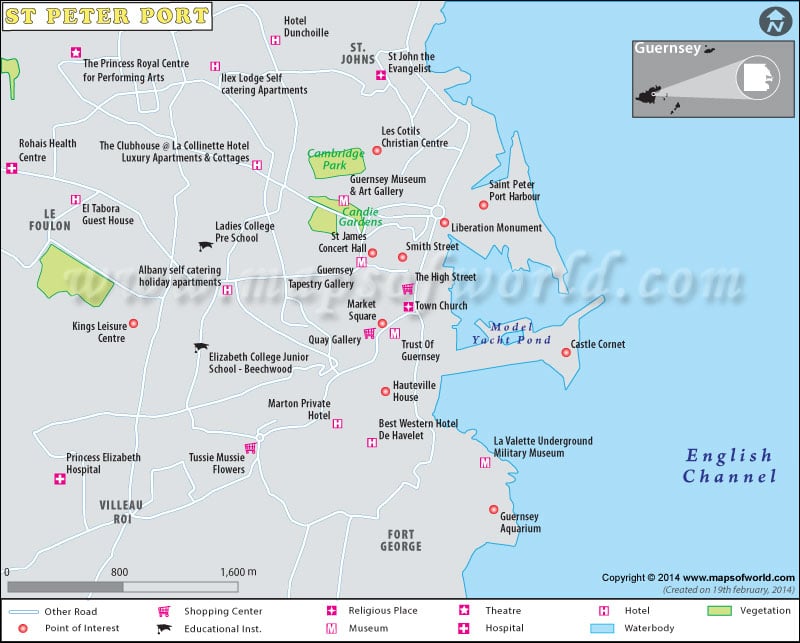Facts About Saint Peter Port |
|---|
| Country | Guernsey |
| District | Saint Peter Port South |
| Founded | 1563 |
| Area | 6.5 km2 |
| Population | 16488 |
| Lat Long Coordinates | 49.4555°N 2.5368°W |
| Time Zone | UTC+1 |
| area Code | GY1 1AA |
| Language | English, French, Guernésiais, Sercquiais |
| Major Religion | Christian |
| Point of interest | The Royal Court House, Hauteville House, The Town Church[dead link, the parish church of St Peter Port, St Peter Port Harbour, Castle Cornet, Elizabeth College, The Guernsey Aquarium, Footes Lane |
About City :
Founded in 1563, the historical town of St. Peter Port is the capital of Guernsey as well as its main port. It has a population of about 18,000. The locals of St. Peter Port were nicknamed “les Villias” or “cllichards” in Guernésias. English is the main language spoken here, though some islanders also speak French, Sercquiais and Guernésiais.
St Peter Port is an ancient port town initially occupied by the Romans. In 933, William of Normandy came to occupy these islands along with the rest of the British Empire. From the 12th to the 14th century, the town suffered through many French invasions but remained under British rule. The town was occupied by the British until Germany invaded it during the Second World War. The country was liberated in 1945 with St. Peter Port as its capital.
Geography :
St. Peter Port covers an area of 6.5 sq km along the East coast of Guernsey. To its North lies the St. Sampson’s, to its South is the St. Martin’s, to the North-West is the Vale and St. Andrew’s is to the West. It faces Herm on the East on the seaward side, and Sark and Brecqhou even further east across the Big Roussel. The Bréhon Tower is located in the Little Roussel in between St. Peter Port and Herm. The city covers a total area of 6.5 sq km and is just a short walk from the harbor with several attractive beachfronts, like Belle Greve, Havelot and Soldiers bay. It is situated against a hillside that sweeps down to one of the world’s most beautiful harbors protected by piers, giving one a true Mediterranean feel. The town consists of a network of narrow lanes and alleyways that rise from the sea to a skyline of church steeples and red roof tops.
How to Reach (Transport) :
The easiest way to reach St. Peter Port is to take a flight to Guernsey Airport which is served by several airlines operating flights to and from cities like London, Rotterdam, Dinard and Jersey. The town is around 6km from the airport and can be reached by a bus or a taxi. The other way to reach this beautiful port is to take a cruise or a ferry, both of which are easily available. The strategic location of this island makes it easily accessible from both the French and the English coast.
Once in the town, one can hire cars and bicycles or flag down a taxi or avail of the local buses coaches to get around. One may even avail of the ferry to access the nearby islands.
When to Visit :
Guernsey boasts of an ideal weather of mild winters and a warm summer. The relatively bright sun accompanied by wide stretches of the seashore make the capital town an ideal tourist destination for an island holiday in the summers, especially in between May and October.
Fairs and Festivals :
- The Town Carnival in summer brings St. Peter Port to life with wide range of entertainment for the children including traditional puppet show Punch and Judy.
- Floral Guernsey Festival Weeks and Walking Weeks in both autumn and spring offer tourists a chance to explore the island on foot.
- Liberation Day, held on 9th May, is an annual national holiday celebrated by all the residents.
- Christmas is also celebrated with much splendor as Christianity is the primary religion here.
Besides these, there are also weekly markets and rural rambles held all over the town.
Points of Interest (Places to Visit) :
- Hauteville House, built around the end of the 18th century was author Victor Hugo’s residence from 1856 to 1870. It has now been converted into a museum and is an attractive tourist spot with beautiful gardens.
- The historical fortress of Castle Cornet, built in the early 13th century, was once the entry to the city’s port. It covers an area of about 2 hectares and is currently a tourist spot as well as home to several museums.
- The 14th century Church of St. Peter is believed to be the finest on the island, besides being the closest church to a pub in the British Isles.
- Elizabeth College was founded by Elizabeth I, the Queen of England in 1563. It is one of the most famous educational institutions of the nation.
- The Guernsey Aquarium was built by the Nazis as a fortified tunnel as a system of defense during the German occupation.
Accommodation :
Accommodation is easily available for those visiting St. Peter Port in the many hotels that are present near the harbor, some of which give an excellent view of the coastline. Among these the Hotel de Havelot is arguably the best. Other luxury hotels are Old Government House Hotel and Duke of Richmond Hotel. Cheaper hotels include Abbey Court Hotel and Sunnycroft Hotel. Bed & breakfast, inns and guest houses are also available at reasonable rates.

 Guernsey Facts
Guernsey Facts